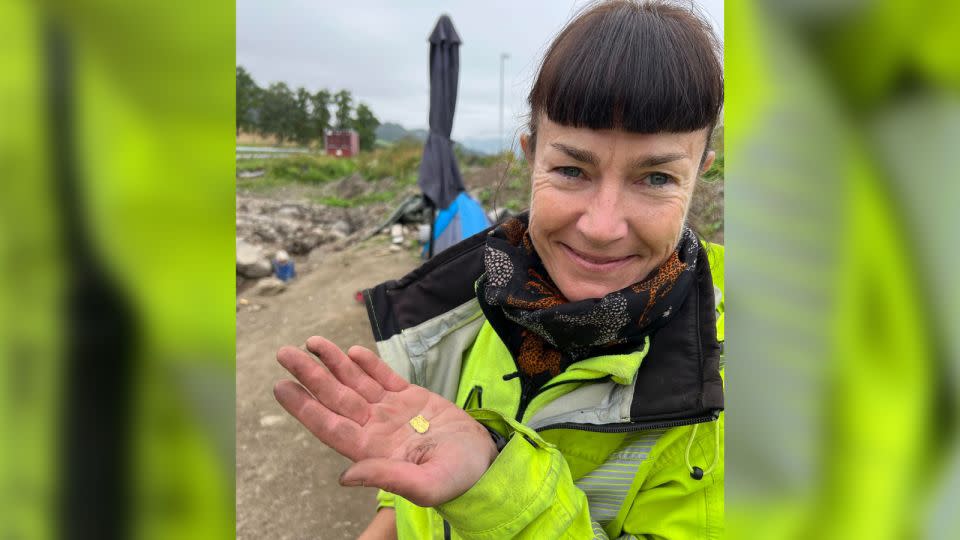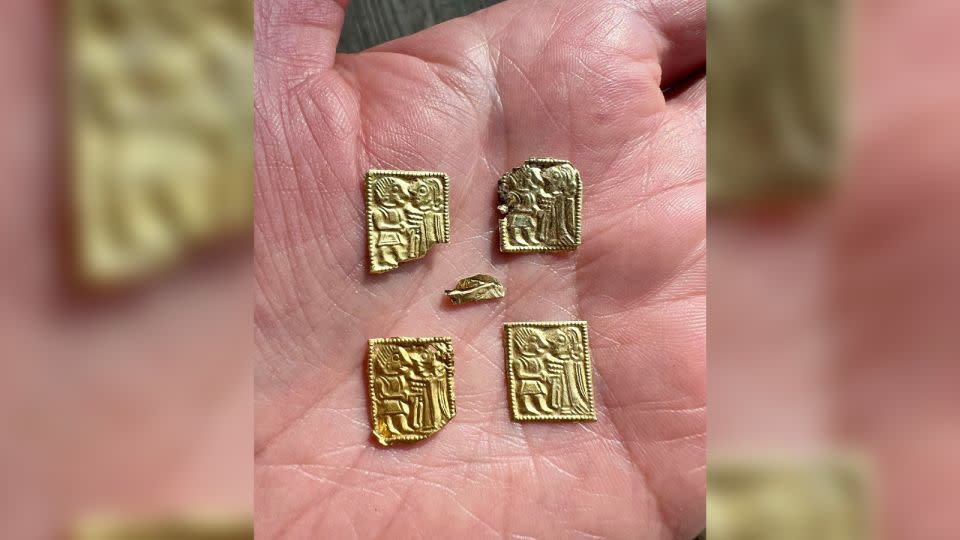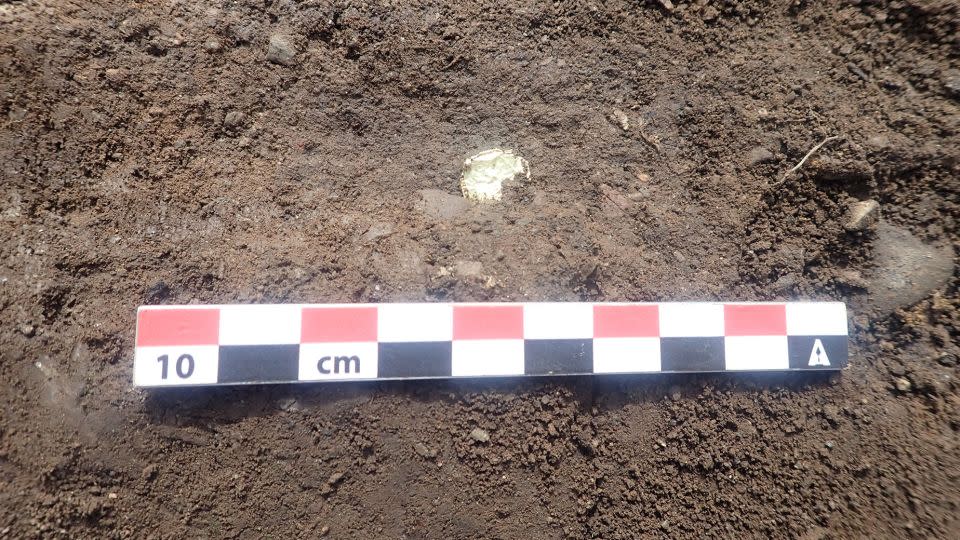5 tiny gold foil figures have been found at a temple in Norway
Sign up for CNN’s Wonder Theory science newsletter. Explore the universe with news on fascinating discoveries, scientific advancements and more.
Each measuring just under 1 centimeter tall, and the width of a fingernail, five newly unearthed mysterious gold treasures found in Hov, Norway, could help unlock secrets of an ancient society, scientists say.
The tiny pieces — intricately detailed gold foil figures discovered during excavations of a pagan religious temple — are a rare find in Norway. The country has only 10 known sites, and Hov has the most foils, with 35 pieces found total. But over 3,000 similar foils have been found across Scandinavia, according to Ingunn Marit Røstad, an archaeologist and associate professor at the Museum of Cultural History in Oslo.
“They’re found in almost all of Scandinavia, but only in Scandinavia,” Røstad said. “You have the same images spread all over Scandinavia, so they must have meant something, the people must have known what they meant, and I think they must have been important to be handled in this way.”
The latest documented artifacts were buried underneath the walls and within post holes of the structure as if they were placed their intentionally, leading researchers to believe that the foils may have been an offering to the building, according to a Facebook post announcing the find. Nicolai Eckhoff, who shared the post, is an archaeologist and adviser in rescue archaeology at the University of Oslo who was involved in the dig.
“They tell us a story about the importance of the area in which they were discovered,” Echkoff said in an email. “The site is found next to Mjøsa (the biggest lake in Norway), at the outlet of the river Gudbrandsalslågen. As such, most trade goods from the mountain regions in eastern Norway must have passed by this site before being shipped toward the shore.

“The figurines and (temple) thus confirm it is as a seat of power in the late Norwegian Iron Age,” he said.
The remains of the Hov temple were uncovered in 1993 along with two gold figures. Subsequent digs turned up 28 more foils there over the following years, according to Science Norway, making it the site with the most Norwegian foil discoveries thus far. The five new pieces came to light over the summer, during a larger excavation made possible by a construction project of a nearby highway, known as the E6.
What the newly found gold foils reveal
While the foils’ designs have distinct references to the Merovingian Period, a pre-Viking period between 476 and 750 AD, exactly what they were made for remains unclear.
“There are many different suggestions (as to the foils’ purpose),” Røstad said. “They must have been placed there intentionally, so I think it’s some form of sacrifice that has been done — probably in connection with some of the rituals that had been taking place inside of this pagan building, perhaps marriage rituals, since very many of these gold foils have pictures of couples on them.”
The gold pieces mostly depict men, women and animals, according to the Bornholms Museum in Rønne, Denmark, the nation where the majority of foils have been found. The figures typically are seen with jewelry, weaponry, drinking cups, types of gowns and robes worn by royalty, and other telltale signs of wealth during this period, and some theories even suggest they represent gods and goddesses from Norse mythology, Røstad said.

The newly found pieces are of particular importance, according to Margrethe Watt — the Bornholms Museum’s retired head of archaeology, who was not involved in the Norway dig — because they were found in their primary context, meaning where they were originally placed.
“Very, very few are found in buildings,” Watt said. “Mostly, they’re just found in settlement sites, where there are buildings, but (the gold foils) are often not connected with a building, they’re often just flying in the soil.”
Gullgubber: ‘A great show of power’
The name archaeologists commonly use for the foils is gullgubber, from the Norwegian word “gullgubbe,” which translates to “golden old men.” The term was first used in an article published in the 1700s and had stuck, Røstad said.
The gold foils were pressed into a stamp dye made of bronze, similar to the process of making a coin, according to Watt. They are made primarily of gold alongside other variations of metal, likely since gold was hard to come by during this period, Watt said.
Furthermore, there are clear distinctions of regional significance within the designs of the gold figures, as well as features of different art styles that help researchers identify which part of Scandinavia each piece of gullgubber was likely crafted.

“The ones that have been found recently, I would never be in doubt that they were found in Norway,” Watt said. “Some of (the figures) may have slightly different jewelry, you can also see the dresses are slightly different, but it’s really the overall look of them.”
The newly uncovered pieces feature a man dressed in a short robe with his feet visible, while the woman is adorned in jewelry and wearing a long Norwegian gown with a train. Because of the intricate details, the gullgubber are used as a “source for studies of the costume customs of the time,” according to Eckhoff’s Facebook post.
The foils are extremely brittle due to their size and composition, according to Watt. Out of the five pieces recently found, one was completely folded up.
“Even though the figurines are small, the inherent nature of gold (the fact that it doesn’t corrode like silver or copper) protects the figurines to some degree,” Eckhoff said.
Eckhoff also said there is evidence that the pagan temple caught fire during the Viking Age, which allowed the gullgubber pieces to be further protected underneath an added layer of stone and debris.
“I think for a regular person, (the foils) must first and foremost have been seen as objects of status,” Eckhoff said. “It must have been a costly affair to sacrifice even such a small amount of gold, and even more when it is such a detailed work of craftsmanship. As such, to be able to sacrifice these figurines, must have been a great show of power.”
For more CNN news and newsletters create an account at CNN.com

